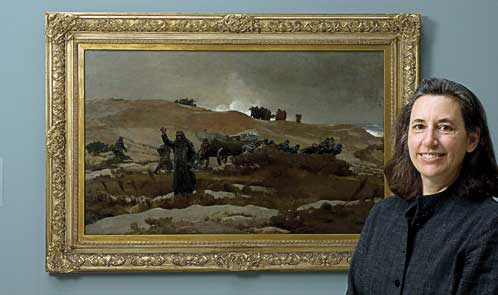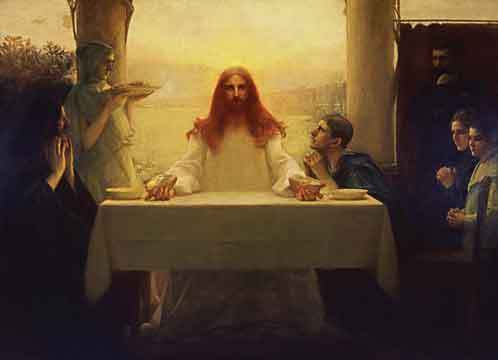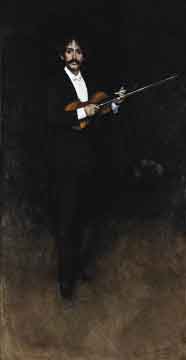Summer 2008
 |
||||
“The decision to purchase the Homer was meant to be a major statement by the museum that they were going to prioritize American artists; that they firmly believed that American painters were as good or better than their European counterparts.”Louise Lippincott, curator of fine arts at Carnegie Museum of Art |
American Doggedness and the Carnegie International
At times both a reflection of and the result of turbulent times, the acquisitions of the early Carnegie Internationals triumphed through determination. Standing on a rock cropping out between the brown grass of a balding, wintery New England coastline, a seaman waves frantically to unseen compatriots. Behind him, already wet from the whip and spray of the Atlantic, a lifeboat crew pushes its rescue vessel across the muck and over a dune, slogging towards a cause no one is yet prepared to declare lost.It’s little wonder that Winslow Homer’s The Wreck found favor among the curators, judges, and audiences of the first-ever Carnegie International, held in 1896. The painting won the exhibition’s top honors, and earned Homer $5,000 in prize money, the most he ever received for a single work in his lifetime. But more than just a supreme example of late 19th-century American painting themes and techniques, The Wreck was something of a raison d’etre for the Carnegie International—particularly in its first few decades of existence, when the exhibition, like the artistic and cultural world it represented, was fraught with turbulence and growing pains as much as it was marked by dedication and conservatism. It also began a tradition at Carnegie Museum of Art of building an esteemed contemporary art collection through acquisitions from each exhibition.  Louise Lippincott in front of Winslow Homer’s The Wreck.Like the fate of the subjects in the stormy The Wreck, the survival of the early Internationals was never a certainty. It hardly helped that its host city had no real foundation on which to build an appreciation for contemporary art. So in its earliest years, the International was an exhibition that sustained itself on a near-religious sense of mission. Part of that mission was to introduce the art world to the art of America. “The decision to purchase the Homer was meant to be a major statement by the museum that they were going to prioritize American artists; that they firmly believed that American painters were as good or better than their European counterparts,” says Louise Lippincott, curator of fine arts at Carnegie Museum of Art. “Beginning in the 19th century, most serious American artists had to solve a basic problem: How do they demonstrate that their abilities and talents were equal to anything in Europe, still seen as the highpoint of civilization, and how would they also create a kind of painting that’s [distinctly] American; creating a national identity in competition with the European model.” That struggle is one that would pervade much of the early period of the Carnegie International, just as it would much of that period in American painting. Because while Europe wrestled with abstraction and modernism, nationalistic fervor, and the consolidation of power that lead to two world wars and the rise of fascism, a still-young America battled to simply find its place in the crowded cultural world. American Idealism
In the far, fifth room of the Scaife galleries, violinist Señor Pablo de Sarasate, shrouded in black-hole darkness, stares across the room towards Christ and the Disciples at Emmaus, a painting that’s all halos of golden light and classical composition. Even today, it seems surprising to see that two such contrasting artworks were added to the collection around the same time by the same director, John W. Beatty. Another imperative with which any International curator is tasked: To build a show that will both appeal to and culturally educate the people of Pittsburgh, a task which both Whistler’s Arrangement in Black: Portrait of Señor Pablo de Sarasate and Dagnan-Bouveret’s Christ and the Disciples at Emmaus fulfilled with fervor.  Pascal Adolphe Jean Dagnan-Bouveret, Christ and the Disciples at Emmaus, 1896-1897, Gift of Henry Clay Frick.Beatty served as the museum’s director of the department of fine arts from 1896-1921, during which time his job consisted largely of organizing its Annual Exhibition, the name of the Carnegie International until 1950. American art was solidifying itself as a cultural force, European art was moving in wild new directions—among them, Impressionism and the abstract nature of Modernism. But in Pittsburgh, Beatty—a local artist himself, not exactly given over to the avant-garde—had to contend with finding balance between building a relevant collection and pleasing a conservative audience. “Both Beatty and [his successor, Homer] Saint-Gaudens were interested in presenting a report on contemporary art from around the world,” says Vicky Clark, writer and editor of the Carnegie International history, International Encounters: The Carnegie International and Contemporary Art, 1896–1996. “They were trying to be fairly broad-based, and none of them really talked about the avant-garde. They wanted to start in 1896 and really move the collection onwards from there, very much in the spirit of progressive American idealism. But that’s not to say they meant Picasso.”
“What Pittsburghers really liked was the Dagnan-Bouveret [purchased by Henry Clay Frick for the museum],” she notes. “Pittsburgh still loves this picture. This was a conservative, religious city, and this is conservative, religious art.” A Changing World
In the 1898 International, that traditionalism was questioned by Beatty’s inclusion—and, the following year, acquisition—of Alfred Sisley’s Saint-Mammès on the Banks of the Loing. By that time, Impressionism was safely embedded in the European art world but was still less common in American shows such as the International. For most Pittsburghers, Sisley’s Impressionist landscape might have been the first glimpse of French modernism. |
|||
Also in this issue:
Celebrating the Mark that Makes Us Human · Voices From Mars · Clash of the “Tyrant Lizards” · Hip to Be Square · Special Supplement: Thanks to Our Donors · Director's Note · NewsWorthy · Now Showing · Face Time: Sam Taylor · About Town: Robotic Wonder · Field Trip: Red Hot Find · Science & Nature: Ready, Set, Go! Sports Works 2.0 · Artistic License: Kinetic Energy · Another Look: Section of Mollusks
 |
Copyright © 2017 CARNEGIE Magazine. All rights reserved. |


